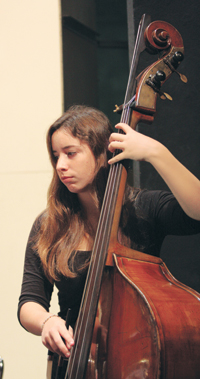 The double bass seems to terrify teachers who play violin, viola, or cello. I think one of the reasons is that the other three are tuned in fifths, but the bass is tuned in fourths. Even “Twinkle, Twinkle” takes more fingering on the bass. The bass also seems so large and yet delicate; it takes more care and effort to move around. It is quite easy to catch a bass on a doorway. Many string teachers want to set their bass students on the right path, but they don’t know exactly what that is and fear giving incorrect information.
The double bass seems to terrify teachers who play violin, viola, or cello. I think one of the reasons is that the other three are tuned in fifths, but the bass is tuned in fourths. Even “Twinkle, Twinkle” takes more fingering on the bass. The bass also seems so large and yet delicate; it takes more care and effort to move around. It is quite easy to catch a bass on a doorway. Many string teachers want to set their bass students on the right path, but they don’t know exactly what that is and fear giving incorrect information.
It used to be that every town had a strong music program, and if teachers lacked knowledge on an instrument, they could call a nearby colleague for help. Now with the removal of so many string programs – and music programs in general – the field of experts has gotten narrower. In the past new teachers could gain knowledge by osmosis; they would watch a fine bass teacher unpack and notice that he never laid the bass down, or that the clarinetist had a big fluffy cleaning rod to run through the clarinet after playing to dry it. They would then pass this information on to their students.
Now teachers have to make a greater effort to add to what they learned in instrumental methods classes in college. I have had many public school teachers take private lessons from me so they can teach bass properly. One teacher who was a fine violinist brought a bass to the ASTA conference. She took some lessons with me and went to bass masterclasses so she could gain a better grasp of the instrument for her students. In the school districts with excellent bass students, there are teachers who have taken the time to learn how to do things the right way and pass on that information.
There are a number of common errors that bass students make. Because the instrument is large and heavy, many relate to proper handling and set-up for playing.
Endpin Placement
The fingers in the left hand should be rounded and arched. When they are not, it is often related to the endpin. If students are playing with flat left-hand fingers, the first thing to check is whether the endpin is stable and anchored on the floor. If it slips out from under them, they will get clocked in the shoulder by the neck of the instrument. This happens to every bassist at one time or another, and it is an experience nobody wants to repeat. What happens next is that attention becomes divided between holding up the instrument and trying to have a good hand position.
The first step is to make sure the endpin is firmly anchored and will not move during playing. When the endpin is not secure, the bassist has to hold the instrument up with his hands. The instrument should be free-standing and lean slightly against the player. Imagine it as a tripod with the two feet and the bass endpin. The feet should be slightly spread apart and the endpin of the bass roughly equidistant from either foot. Students should be able to remove both hands and have the bass lean against them a bit but not fall. Violin and viola players support the instrument with the shoulder so that they can move the left hand freely to shift and play. The same is true with the bass; if the left hand supports the instrument, it can not move easily around the fingerboard.
There are a variety of choices to keep the endpin securely in place. Endpins come with a spike at the end and a rubber tip that can be removed. An endpin with a rubber tip will work on any kind of floor. Make sure that the rubber tip is in good shape. Often the spike has worked through the rubber tip, or the rubber tip is missing altogether.
Bass players sometimes remove the rubber tip and just use the spike alone on tile and wood floors. They often enjoy playing with just the metal spike on a wooden stage. When they put the spike directly onto the wood, it makes the whole stage act as a sounding board and vibrate with the instrument. A rubber stopper on the endpin prevents the vibrations from reaching the stage. Unfortunately sometimes students forget to put the rubber tip back on, and it is lost.
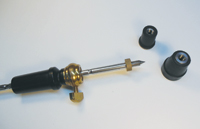 The cello, with its lighter weight, can use a larger variety of rock stops. They do not have to support as much weight and at such an angle as a bass does. One option is to use screw-on rubber endpin tips, which can be found at some bass shops. There is a plug of metal that screws onto the bottom of the endpin, and then the player puts a crutch tip on that metal plug. The beauty of the metal plug is that the spike on the endpin never touches the rubber and does not poke a hole in it.
The cello, with its lighter weight, can use a larger variety of rock stops. They do not have to support as much weight and at such an angle as a bass does. One option is to use screw-on rubber endpin tips, which can be found at some bass shops. There is a plug of metal that screws onto the bottom of the endpin, and then the player puts a crutch tip on that metal plug. The beauty of the metal plug is that the spike on the endpin never touches the rubber and does not poke a hole in it.
Another inexpensive option is to go to a carpet store and ask for a small piece of a rug with a foam rubber back. A five-inch square is sufficient, and stores often have old sample swatches that they will give for free. Students put the endpins in the carpet, and the foam rubber keeps the instrument from slipping. Another solution that Sandra Dackow thought of is to take an outgrown sneaker and put the endpin in there. It keeps the instrument very stable and sturdy. When the endpin is properly stabilized, bass players can use their hands to freely bow and shift.
Endpin Height
The height of the endpin can affect the position of both hands. Students start the bass in middle school and are taught to set the endpin at an appropriate height. As they grow, they often do not realize how much they should raise the endpin to adjust to their new height. Sometimes the endpin may not even move freely and may be stuck in its current position. This comes from students being careless. If the endpin is bent because it was bumped, it will neither go in nor out again.
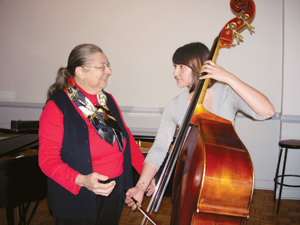 Students may not know how to correctly set the height of the instrument. An old method that some teachers may have learned was to place the level of the nut at the eyebrow. This is usually where the bass ends up when adjusted to the proper height but not always. The correct way to adjust the height of a bass is by where the bow falls; the bass is not played with the eyebrows but with the bow. Have students stand properly in a relaxed manner, with the right hand holding the bow parallel to the floor. Check whether students can move the bow down to the bridge without dropping the right shoulder or bending at the waist. Bass players should be able to place the bow up by the fingerboard and down to the bridge with the same stance. It is where the bow hand can reach that determines the height of the endpin, not a physical marker on the head or face in relationship to the scroll or nut.
Students may not know how to correctly set the height of the instrument. An old method that some teachers may have learned was to place the level of the nut at the eyebrow. This is usually where the bass ends up when adjusted to the proper height but not always. The correct way to adjust the height of a bass is by where the bow falls; the bass is not played with the eyebrows but with the bow. Have students stand properly in a relaxed manner, with the right hand holding the bow parallel to the floor. Check whether students can move the bow down to the bridge without dropping the right shoulder or bending at the waist. Bass players should be able to place the bow up by the fingerboard and down to the bridge with the same stance. It is where the bow hand can reach that determines the height of the endpin, not a physical marker on the head or face in relationship to the scroll or nut.
Standing vs. Sitting
I am not a big advocate of sitting on stools while playing; I prefer standing. However, conductors should provide rehearsal stools for players during rehearsals that are longer than 45 minutes. Bassists rarely really sit, they just perch on the edge of a stool. Stools make it easier for bassists to remain connected with the rest of the orchestra and at eye level with the conductor and music. Band directors have similar battles with percussionists. Bassists should have a stool so they will properly pay attention.
Bass students who have chairs available are likely to sit during rests or while the conductor works with another section. This is a really bad habit because when bass players sit on regular chairs, the high music stands form a wall over which they cannot see. Sitting bass players cannot see the music or conductor, and bassists who do this often miss out on a large portion of the instruction that the conductor is giving the group.
Instrument Care
It makes me shudder to see bassists putting the bow in the f-hole as they carry the instrument. All it takes is for someone to bump the bow, and the whole top of the bass can be broken. The f-holes on other string instruments are too small to fit the bows, so this is solely a bass problem.
Many students unpack their basses improperly. Before rehearsal starts watch for bassists taking their instruments out the way a violinist does by laying the instrument down flat on its back. A bass should never be laid down; all packing or unpacking should be done with the instrument standing up on the endpin, which should be all the way in.
I have puzzled for years about why someone would put a bass on its back before unzipping the case. I finally realized that teachers who are not bassists are teaching students to unpack the bass the way they would a violin or viola. When basses are laid on their backs, the two points of contact are the delicate back and the scroll. There never should be weight on the scroll; the neck and especially the neck block, where the neck joins to the body, are very delicate on the bass. If that neck block comes loose, it is a difficult repair.
Another terrible habit is for the player to take the case off the instrument before removing the bow. It is easy to snap a bow in half; the bow should come out of the case first and go in last at the end of rehearsal. (This is true for cellists as well.)
Teach students to unpack in the proper order. First stand the bass up in the case and take the bow out. Hold the bow carefully under the arm rather than putting it on a chair or stand where it can be knocked to the floor. Then take the case off the instrument.
Extra Equipment
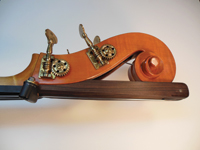 Some basses have a low C extension; this is an extended piece of fingerboard under the E string that extends the range of the instrument down to a C. With a fingered extension the player reaches back and presses the string with the fingers. Other basses use more complicated mechanisms with levers or buttons that the player pushes to produce a pitch. If the option is available, always choose to install a fingered extension; the ones with levers cause a buzzing sound in the string and break so frequently that the bassist will need to have a screwdriver available at all times. On fingered extensions use emory cloth to check for sharp places on the tuning gears that could cut the hand and then carefully sand them down.
Some basses have a low C extension; this is an extended piece of fingerboard under the E string that extends the range of the instrument down to a C. With a fingered extension the player reaches back and presses the string with the fingers. Other basses use more complicated mechanisms with levers or buttons that the player pushes to produce a pitch. If the option is available, always choose to install a fingered extension; the ones with levers cause a buzzing sound in the string and break so frequently that the bassist will need to have a screwdriver available at all times. On fingered extensions use emory cloth to check for sharp places on the tuning gears that could cut the hand and then carefully sand them down.
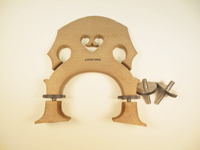 Bridge adjusters are important because bass strings are often not the proper height off the fingerboard. They are either too low and buzz and rattle, or they are too high, and young students cannot push the strings down enough to produce pitches. Bridge adjusters fix both of these problems quickly and easily. Teachers should check and make adjustments with changes of season and atmospheric conditions. Aluminum bridge adjusters are the best choice. They are lighter and transmit vibrations better than ebony or brass, which are dense and hamper the vibrations of the strings.
Bridge adjusters are important because bass strings are often not the proper height off the fingerboard. They are either too low and buzz and rattle, or they are too high, and young students cannot push the strings down enough to produce pitches. Bridge adjusters fix both of these problems quickly and easily. Teachers should check and make adjustments with changes of season and atmospheric conditions. Aluminum bridge adjusters are the best choice. They are lighter and transmit vibrations better than ebony or brass, which are dense and hamper the vibrations of the strings.
Another bass-specific topic is the tuning gears. Other string players have difficulties with pegs that slip, but bassists do not have to worry about that. Instead tuning gears sometimes develop too much play. It might be necessary to turn them quite a bit before there is any adjustment to the pitch, but then there may be a sudden drastic change. This only occurs when trying to lower the pitch of a string. The tuning machine shaft the string connects to may stick for a bit before coming loose to catch up to the gear. This can drop the pitch of a string as much as a minor third.
The proper set-up and equipment will help students play this versatile and rewarding instrument successfully. The bass provides a wonderful opportunity for students to play in orchestra, concert band, and jazz ensembles, and many particularly enjoy the physicality of playing this large, vibrant instrument. There is a special richness and resonance to the double bass. I knew Samuel Applebaum, who wrote the String Builder series of books that was introduced in the 1960s and is still in use today. He was a violinist but once mentioned that he kept a bass in his bedroom. Before going to sleep each night, he would stroke the strings for a while because nothing would ensure him a blissful night’s sleep like the deep, soothing, satisfying tones of the double bass.






